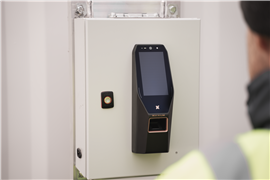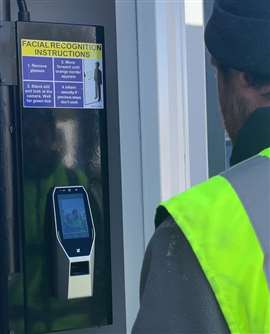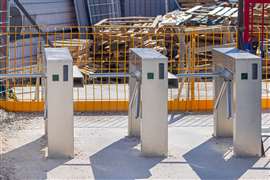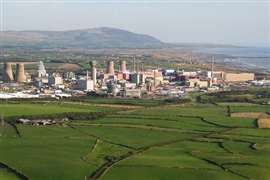How construction site access tech is advancing – and what it can do for you
30 November 2023
Construction site access has moved a long way from a simple turnstile to let workers in and keep others out. New tech and the huge quantities of data means suppliers want to offer all sorts of extra services – from keeping tabs on work quality to checking site operatives’ qualifications and right to work.
 A construction worker in front of a facial recognition scanner (Image: Datascope)
A construction worker in front of a facial recognition scanner (Image: Datascope)
Using a swipe card to access a construction site is now a thing of the past.
At least, that’s according to the companies offering site access solutions.
They helped major tier one contractors graduate to fingerprint recognition at turnstiles some years ago and then moved on to facial recognition during the pandemic. Both types of system take less than a second to match workers to a database.
But it isn’t just the technology governing how workers enter a construction site that’s changing, it’s what you can do with the data that these more sophisticated systems generate.
“Biometric access control has pretty much been de facto with our customers even since I have worked for the business and that has been for six years,” says Jasmine James, bid manager at access control and construction site management company Datascope Systems.
“Nobody really uses cards these days because the there are multiple problems with them,” says Chris Philpot, business development manager at Biosite Systems, an access control and workforce management company.
“Just because you’ve got a card doesn’t mean it’s you. There’s also the risk of things like pass-back. So I touch my card and then pass that back and then you go through.”
Little wonder that contractors are opting for less fallible biometric systems. Adopted first by tier one contractors, smaller firms are also taking up such systems and in the case of sites – such as major civil engineering or housing projects – where physical access can’t be tightly controlled, there are app-based systems that use geofencing to determine who is on site and where.
The certainty these new systems create as far as the identity of individuals is concerned is also opening up new possibilities for workforce management.
Philpot sees site access as breaking down into two elements: first of all site security, the physical boundaries of the site, and the security elements used to control access; and secondly the data that site access systems generate.
Site security
“One of the big elements now is who’s getting onto site and should they be there, not just from an intruder point of view, but actually from a worker point of view. Are they competent and are they correct?” he says.
 Image: Datascope
Image: Datascope
Systems are now allowing contractors to determine first of all, not only if someone is allowed through into a site, but also how and when they can enter, he explains.
An individual worker’s biometric information can be linked to their competencies and qualifications as well as health and safety documentation. Contractors can use the access control systems to limit areas of the site they can access, based on that information.
It allows those in charge of a site to deal with a range of security-related questions, Philpot explains: “Am I competent? Am I trained? If I have an accident on site, should I be there in that scenario? If you haven’t been to site for six months and you suddenly come back, why are you coming back? Are you up to no good or is there a genuine reason? Or you may have been blocked access for a reason. You may have been involved in abusive behaviour, for example.”
James explains that Datascope’s access control system is also integrated with its time and attendance system.
“There’s lots of zones on a construction site. It’s absolutely critical that people don’t walk into those areas unless they have the appropriate qualifications,” she says.
“We have a competency module on our software where workers’ qualifications are uploaded against their record. The construction sites can define what they deem critical competencies. They have to be valid for access to certain areas to be granted.”
Workforce management
But the systems are starting to go beyond security and determining who is allowed access where. The huge quantities of data they generate are also enabling contractors to study how people are working on site and make changes to boost efficiency and safe working practices.
“It might be that we have some projects where you have systems in place for both the main contractor and the subcontractor because they are working together or have different objectives. The main contractor may have a turnstile that everyone has to go through and then the subcontractor might have a smaller unit themselves on the same project,” says Victoria Kesterton, Biosite’s marketing manager, who cites the example of the UK’s ongoing high-speed rail megaproject HS2.
“The main contractor might challenge a subcontractor as to how many workers were on site and how many hours they worked. The subcontractor can then look for evidence to prove that their subcontractors were there.”
Harnessing the data from access systems also proved its worth during the pandemic, says James.
“One of our customers used data on when people were clocking in and out to analyse pinch points. They were looking for upticks in arrivals of operatives on site. And then they could use the data to find ways to smooth that out because during the pandemic you didn’t want hundreds of people coming to site all at the same time,” she explains.
Other customers have used data from access control systems to enhance fatigue management, she adds. “They can set up alerts if operatives have exceeded a 12-hour shift, or they have had less than 12 hours between shifts,” she says.
 Card-based turnstiles are becoming a thing of the past, according to Biosite Systems (Image: markobe via AdobeStock - stock.adobe.com)
Card-based turnstiles are becoming a thing of the past, according to Biosite Systems (Image: markobe via AdobeStock - stock.adobe.com)
And Philpot said such systems could also let contractors compare hours on site versus the construction programme. “They can overlay the physical data with their programme and understand if they got the programme wrong or if the amount of time operatives spent on site was wrong,” he says.
It can also help employers to understand labour churn rates, as well as comparing churn rates to snags to see if there is a correlation. “That helps contractors to understand not just how much they are paying a subcontractor but actually if there are any differences between them – one may be more expensive but their churn rate could be lower and their quality higher,” he explains.
What does the future hold?
As far as how access control and the technology behind it might evolve in the future, the companies offering it hope to see further integration with the other aspects of a construction site operation.
“Access control is literally just the starting point,” says James. “One of the key things we have integrated recently and are continuing to develop is using access data in our other modules such as our health and safety model. We have a digital permit system, so rather than people filling in permits for things like hot works, it is all done in the app.”
That allows Datascope’s systems to link operatives directly to permits. And that is where access control comes in.
“We have an audit trail of exactly who has carried out work on site and where, and we could even use the system to limit an operative’s access to a certain area if, for example, they didn’t have the right permit,” she explains.
She adds, “For us it’s very much looking at integration with wider systems and trying to make that data work in more efficient ways because there is an issue with software fatigue in the industry. Construction is saturated with all these new digital solutions. We want to find ways to make that easier so people are only enter data once using a small number of systems and making that data work better.”
For Philpot too, further integration of data is key to future developments.
“One of our real drivers is about bringing together multiple layers of data into one database,” he says.
“We are bringing all sorts of things – competency, risk assessment method statements (RAMS), briefings, snags, legal status to be in the country – into a central repository where you can then really start to identify that data at an intrinsic level and slice and dice in different ways.
“Gut feel isn’t the way forward, especially when cost is so prevalent.”
CONNECT WITH THE TEAM









